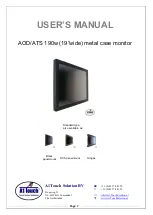
44
E
Troubleshooting
If you are experiencing any problem with your display, before
calling for service, please review the following troubleshooting
tips.
There is no picture or sound.
• Is the power cord disconnected? (See page 14.)
• Is the main power switch off? (See page 18.)
• Is the monitor in standby mode (the power LED illuminating
in orange)? (See page 18.)
• Make sure correct input mode is selected. (See page 20.)
• If any external equipment is connected, make sure the
equipment is operating (playing back).
Remote control does not work.
• Are the batteries inserted with polarity (+,-) aligned? (See
page 17.)
• Are the batteries exhausted?
• Point the remote control unit toward the monitor’s remote
control sensor. (See page 17.)
• Is operation disabled? (See page 30.)
Sound from left and right speakers is reversed.
• Are audio cables connected properly?
There is a picture but no sound.
• Is the sound muted?
• Make sure the volume is not set to minimum.
• Are audio cables connected properly?
• Is the cable correctly connected to the PC audio input
terminal or AV audio input terminal as appropriate for the
input mode? (See page 13.)
• Is AUDIO OUTPUT or SPEAKER correctly set on the
SETUP menu? (See page 29.)
Unstable video.
• The signal may be incompatible.
The video from the HDMI input terminal does not appear
properly.
• Is the HDMI cable HDMI standard compliant? The monitor
will not work with cables that are not standard compliant.
• Is the input signal compatible with this monitor? (See page
49.)
• If an AV signal such as 1920 x 1080i, 720(1440) x 576i, or
720 (1440) x 480i is displayed using the HDMI[PC] input,
display problems such as faint colors may occur. Display
using HDMI[AV].
The video from the DVI-D input terminal does not appear
properly.
• Is the input signal compatible with this monitor? (See page
49.)
• Turn off the power to the connected equipment and then
turn the power on again.
• If the monitors are connected in a daisy chain, turn off the
power to all the monitors connected in a daisy chain and
then turn the power on again.
• If an AV signal such as 1920 x 1080i, 720(1440) x 576i,
or 720 (1440) x 480i is displayed using the DVI-D input,
display problems such as faint colors may occur. Display
using HDMI[AV], D-SUB[COMPONENT] or D-SUB[VIDEO].
The video from D-Sub input terminal does not appear
properly.
• Is the input signal compatible with this monitor? (See page 49.)
Control buttons do not work.
There is no picture.
• Load noises from outside may be interfering with normal
operation. Turn off the power and turn it on after waiting at
least 5 seconds, and then check the operation.
The monitor makes a cracking sound.
• You may occasionally hear a cracking sound from the
monitor. This happens when the cabinet slightly expands
and contracts according to change in temperature. This
does not affect the monitor’s performance.
Operation is not possible when a USB flash drive / SD
memory card is connected.
• Operation using the remote control or otherwise may not be
possible if a USB flash drive and SD memory card are both
connected. Switch off the main power switch, remove either
device, and then switch on the main power switch.
It takes a longer time until the monitor starts up.
• When a USB flash drive or an SD memory card is
connected, it is better to turn the power ON/OFF using the
remote control unit. When the power is turned ON using
the main power switch with a USB flash drive or an SD
memory card connected, the monitor startup takes a longer
time because the monitor checks USB terminal or SD card
slot connection after checking other terminal connections.
A file in the USB flash drive or the SD memory card does
not play properly.
• Is the file in a supported format? (See page 26.)
The following problems may occur if a non-supported
format is used:
- The file does not play properly.
- Pausing or Move forward/back cannot be performed
during playback.
- Abnormal play speed
- Operations cannot be performed during playback
- Playback stops. The player application restarts.
• When using a USB flash drive, is the cable connected to
the power supply terminal? (See page 10.)
• Are both a USB flash drive and SD memory card
connected? These cannot be connected simultaneously.
The screen turns black when a file in a USB flash drive or
an SD memory card is played.
• The screen will turn black if none of the files in the play list
are in the USB flash drive or the SD memory card. Press
INPUT
to exit.
No power is supplied from the power supply terminal.
• Is the cable connected to the USB terminal? (See page
10.)
• Check the power specifications (5V, 2A).
• If overcurrent occurs, a protective circuit will activate and
stop the supply of power. Remove the connected device
and then eliminate the cause of the overcurrent.
The USB flash drive is not recognized.
• Did you connect an unsupported device such as a USB
keyboard? Switch the main power switch off and on.










































